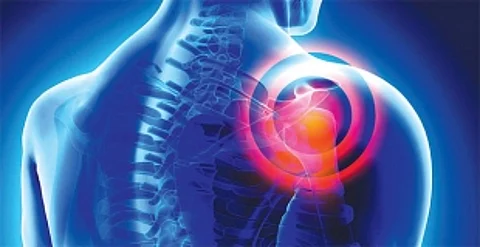

The normal shoulder is one of the most mobile joints, and permits us to place our hands where we
need them, and helps us make the most of the environment that we live in. One
of the common problems faced by many people is that of a frozen shoulder.
Frozen shoulder is referred to the condition in which the shoulder joint
becomes painful and develops stiffness gradually over time.
The Shoulder Joint is a complex
ball-and-socket joint where the ball shaped upper end of the arm bone (humerus)
articulates with the cup shaped socket in the shoulder blade (scapula). Strong
connective tissue, called the shoulder capsule, surrounds the ball and socket
joint. The capsule and ligaments surrounding the shoulder joint hold the bones
together and permit movement in a safe manner. The muscles around the shoulder
help move it in such a beautiful and well-coordinated manner. The capsule is
lined with special cells that make the joint fluid that lubricates the joint,
keeping the movements friction free and smooth.
Frozen shoulder is thought to be a result
of inflammation of the shoulder joint capsule, resulting in stiffening of the
shoulder. The shoulder joint capsule becomes thickened and stiff. The shoulder
becomes very painful and movements at the shoulder become reduced over time.
The inflammatory process in the shoulder may be triggered off by
a minor illness such as a viral fever, a trivial injury to the shoulder, or
sometimes situations where the shoulder was left immobile for some time. This
painful and stiff shoulder problem is more common in Diabetics, although it is
not clear as to why Diabetes makes our shoulders more susceptible to this
inflammatory process. Long working hours, irregular dietary habits, stressful
and sedentary lifestyle along with lack of regular exercise is often blamed for
leading on to such problems. Most often, frozen shoulder is seen in people
older than 40 years; however, the problem is gradually becoming more common in
younger people. This urges us to try and prevent such problems.
The symptoms of a frozen shoulder are dull aching shoulder pain,
with the patient complaining of severe pain with shoulder movements. Over time,
it is noticed that the movements at the shoulder gradually become reduced.
Often, the pain is worse during the night, disturbing sleep.
Frozen shoulder usually progresses through stages:
Freezing stage: This is when any movement in the shoulder
initiates pain and the shoulder’s range of motion gradually becomes limited.
Frozen stage: Even though the constant dull pain may
reduce, the shoulder becomes stiffer and extremely difficult to move.
Thawing stage: This is when the limit of the shoulder’s
motion starts improving.
It can take a year to three years or so for a frozen shoulder to
go through these stages and resolve.
While frozen shoulder can be severely painful and disrupting,
becoming a hurdle in everyday routine activities, it is something that can be
resolved with a few simple steps, most of which involve self-care.
Diagnosis and
Investigations
The diagnosis is most often made based on a detailed evaluation
of the patient and clinical examination. Your orthopaedic surgeon may sometimes
take an X-Ray to rule out other potential problems that may cause a painful,
stiff shoulder. Sometimes, an MRI is used to evaluate the shoulder in greater
detail.
Preventive measures
For any other reason, such as after an illness or an injury to
that upper limb, due to which the shoulder movements are reduced may lead onto
a frozen shoulder, early active mobilisation of the shoulder would help prevent
the onset of this problem.
In people who are diabetic, and those with hyperthyroidism or
hypothyroidism, it is recommended to seek treatment to maintain these
conditions under good control. This is thought to reduce the chances of frozen
shoulder.
Remedies for a frozen
shoulder:
Lifestyle plays a major role in deciding the severity of frozen
shoulder and the time it takes to heal. Maintaining good control on Diabetes,
thyroid problems if present, is thought to help hasten recovery.
Actively use the involved shoulder frequently as much as
possible to eventually improve the pain and range-of-motion. However, it is
recommended to avoid heavy weights and strenuous use of the shoulder.
Warm packs or ice packs can also be applied to relieve the
shoulder pain. Warm water fomentation is commonly used to reduce pain and
permit more movement at the shoulder.
A visit to an Orthopaedic Surgeon to confirm the diagnosis, and
then work with a physiotherapist to learn range-of-motion exercises goes a long
way in bringing this shoulder back to its normal self.
With determination, self-care and regular exercises, there is
gradual improvement in the shoulder
In more severe
painful shoulders, the following may help:
The initial pain and inflammation can also be reduced with
certain regular pain relievers prescribed by an orthopaedic surgeon.
Alternative medicines like acupuncture could work if done
properly, especially to assist in relieving pain.
Transcutaneous electrical nerve stimulation (TENS) is also one
of the physiotherapy treatments that can help in control of pain.
Occasionally, further
treatment may be indicated:
Steroid injections into the affected shoulder joint to bring down
the pain and improve the mobility of the shoulder, especially in the early
stages.
Injecting sterile water into the joint capsule is sometimes done
to help the tight capsular tissue to stretch, thereby reducing the stiffness
and ease movement.
A shoulder manipulation under anaesthesia might also be done by
the orthopaedic surgeon to help regain movements in the shoulder.
Frozen shoulder requiring surgery is extremely rare. Sometimes,
if it does not resolve and X-Rays and MRI scans reveal tight, thickened capsule
tissue that is adherent and limits movements. Occasionally, this needs surgical
release by arthroscopic surgery to remove adhesions and scar tissue from inside
the joint, and assist in restoring movements to the shoulder
The writer is a Consultant, Orthopedics, at Columbia Asia Referral Hospital Yeshwanthpur